
Design system: Facebook Privacy

“Our mission is to reduce privacy people problems for Facebook users by putting privacy policies and principles into practice and creating efficient processes for product teams.”
My Role
I led the Facebook Privacy design team, created clear design solutions around people's privacy problems, and tackled privacy system-level opportunities with many legal and product constraints. Proactively collaborate with XFN (cross-functional) peers to strategize and execute projects. Worked closely with other Meta teams (Privacy central, Instagram, Whats App) to deliver consistent privacy solutions for our users. Use my creative power to transform a tedious and complex product into one that is delightful and simple to use.
Context


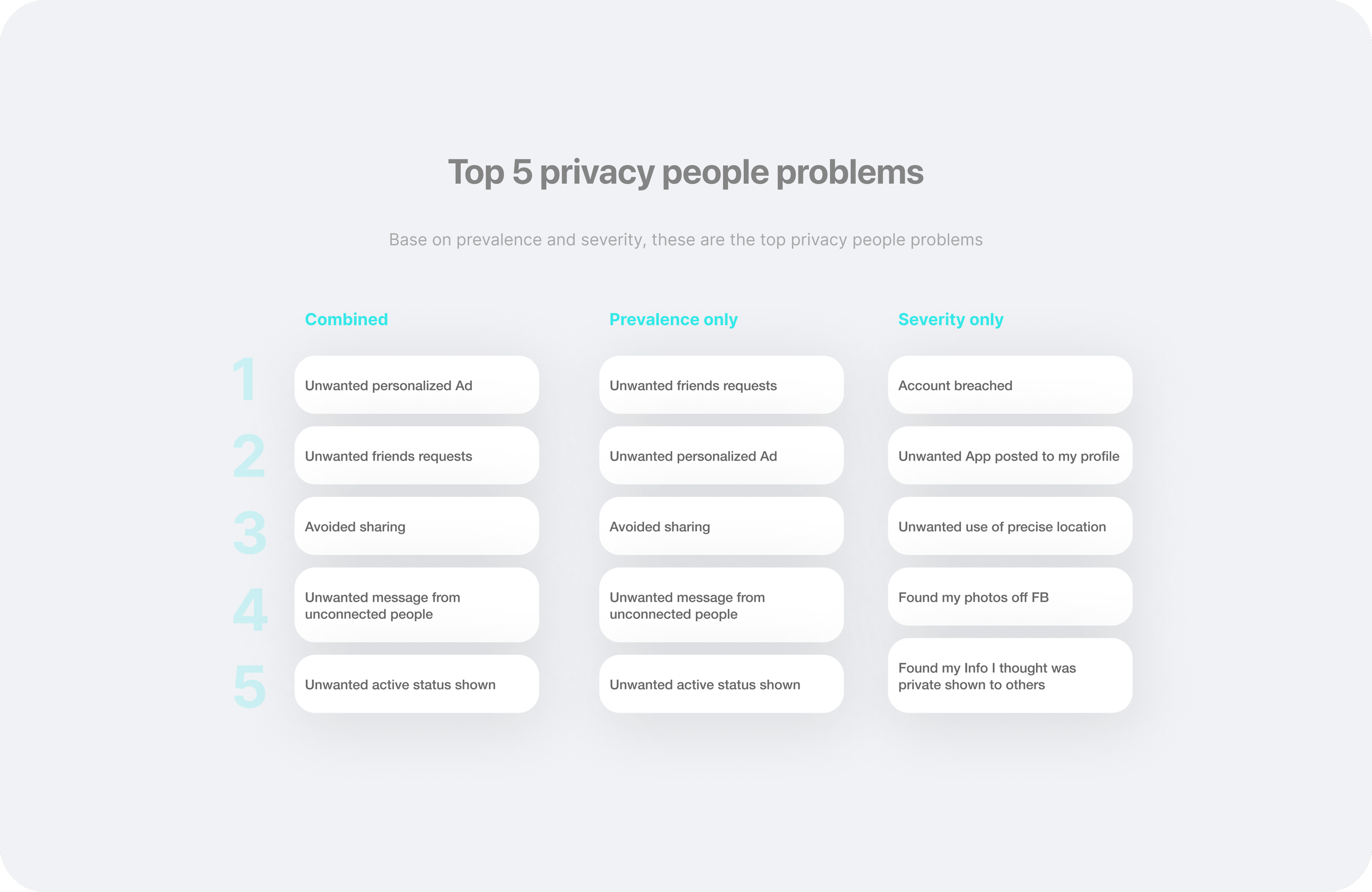
Strategic
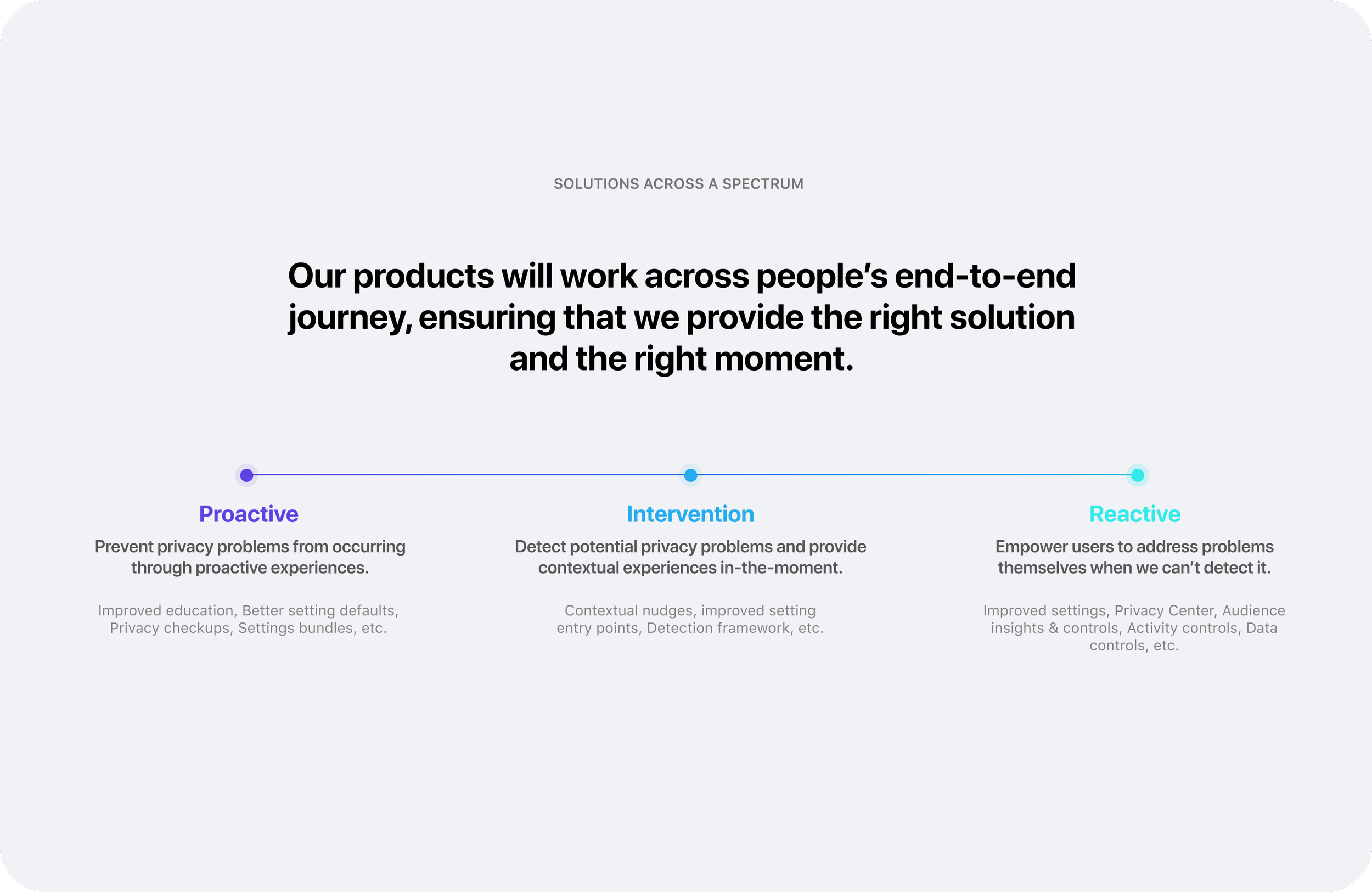
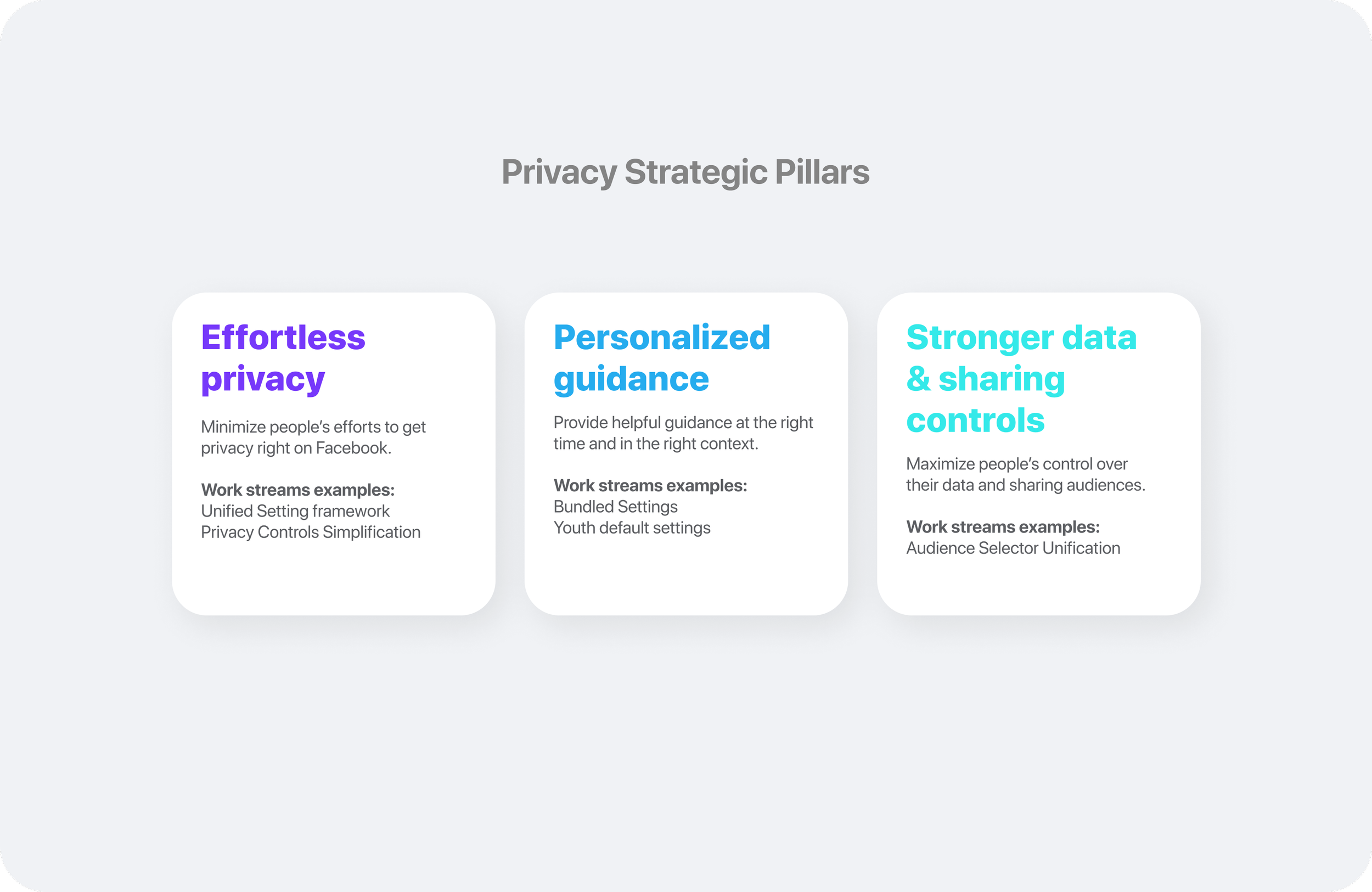
Unified Settings Framework
Before, if you had opened the Facebook app, you would have found inconsistent settings across the entire platform. Our users need to read very carefully to understand the meaning of each setting. It had similar settings with various styles and options. For example, the Post settings Vs. Story settings, Marketplace settings Vs. Dating settings. All the inconsistencies make it difficult for users to make precise settings decisions, and there is also a high risk associated with the potential privacy SEV (Site Events) issue. Don't even need to mention the high maintenance cost and delayed updates.
One major impact I have had on the privacy team is establishing the Unified Settings Framework. I handled a system-level problem with numerous constraints. Provide flexible design solutions to the complex Settings environment, including new user-centered IA, modular Bloks component, and engaging interaction behavior. Bring product system thinking, interaction design, and craft execution to the Settings. We've transitioned the majority of users to the new consistent Settings IA, which now accounts for 93% of all FB Settings mobile impressions. More importantly, I created the USF Settings Guideline to help the system scale. All Facebook settings will soon be moved to USF and USF Bloks.

Posts, Stories, Reels settings all merge under ‘Your content’. Intuitive consolidations in tiers and familiarity with tab design enabled easy findability and predictability.
User value
- Enable the search function for settings. Impressions and setting changes increased by 5.5% and 10.2%, correspondingly, when USF search results were linked to the parent category for context.
- Quicker access to the settings.
- Connect USF with the Facebook Help Center. Let us double the number of users we help daily while maintaining around a 30% action rate.
- The responsiveness screen load rate (<1 sec) increased from ~39% to 68.9%, while the contingent screen load rate (<2 secs) increased from ~79% to 90.5%. This brings the Settings Menu screen in conformity with the standard FB contingent screen load rate (>85%).
Developer efficiency
- Reduce the setting's average development time from 2.5 to 0.7 days.
- No additional activity is required when partners need to adapt to USF Bloks.
- Debugging USF settings is more manageable than before.
Regulatory response efficiency & Risk reduction, prevention
- Respond to regulations up to 75% faster
- Addressing Accessibility (AX) at scale with 0 extra cost to partner teams
- USF's Test Suite prevents up to 2.7 SEV per month
- The average test coverage for all settings on USF is over 90%
Language setting in Android
Privacy Controls Simplification
Users have difficulty finding and using our settings and controls. In a recent study ~10% reported that they “could not find the account setting [they] wanted to change” when they tried to in the last 7 days. This means we’re not meeting user or regulatory expectations. Moreover, people who experienced these pain points were more likely to reduce engagement compared to those who did not. We have the opportunity to increase people’s confidence in our ability to respect their explicit preferences around privacy and content. It’s critical to ensure people feel safe and secure to engage on the platform.
Simplify (consolidate and deprecate) settings and controls and unify the experience for increased findability, improved understanding and actionability to increase people’s confidence that they have agency over their experiences.
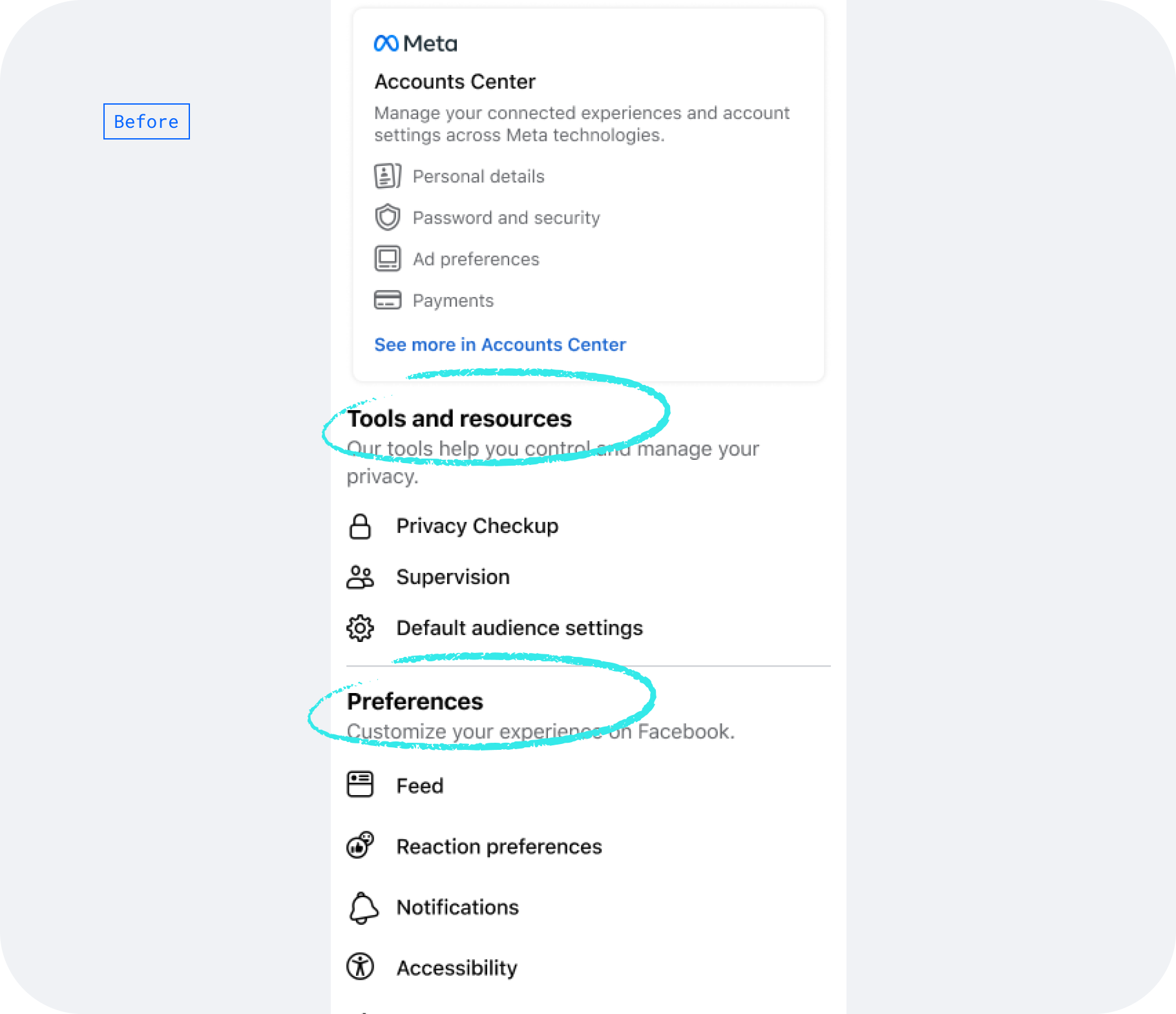
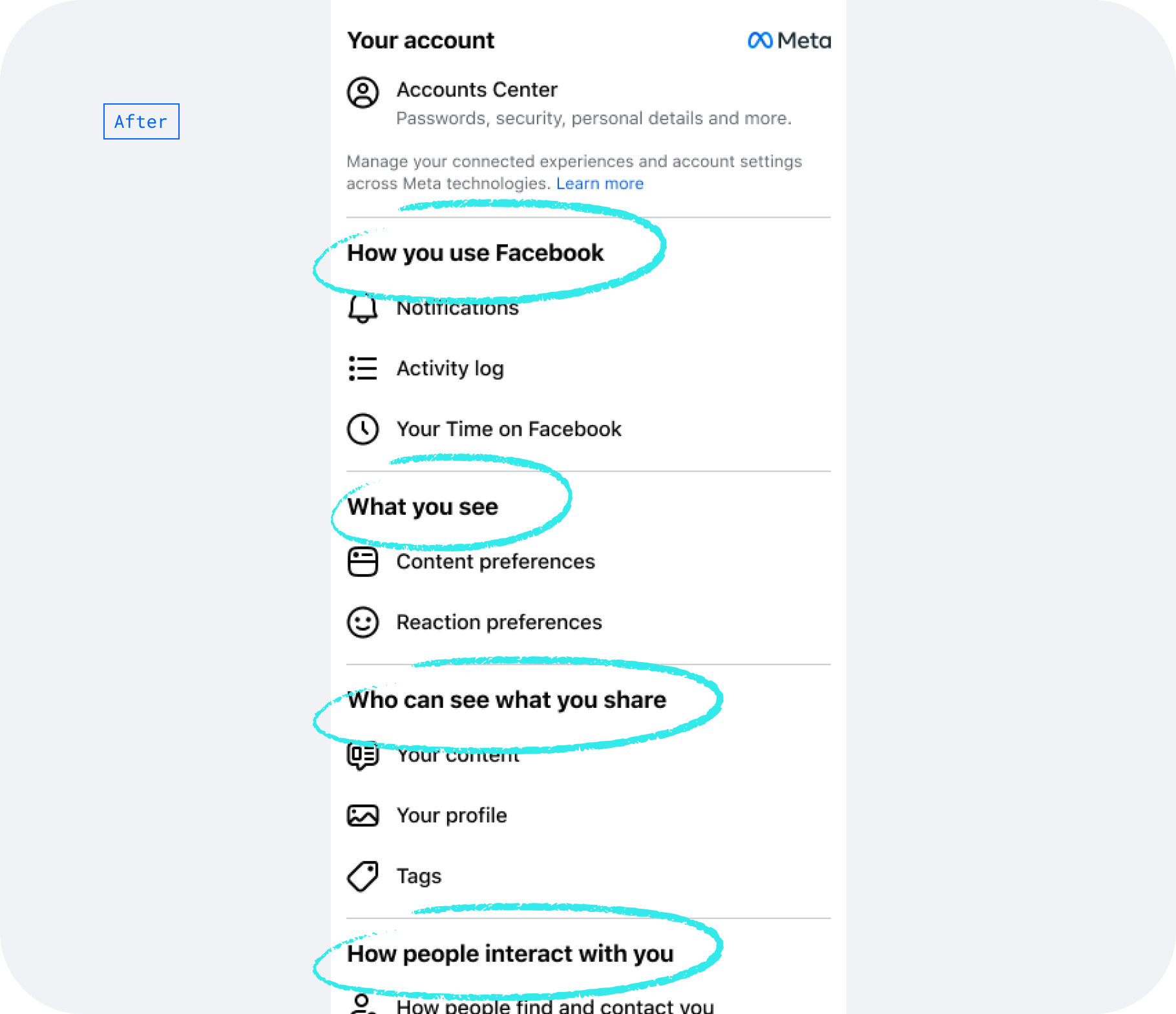
Using humanistic language helps us clearly group settings around core jobs, aligns with users’ mental models, and ensures people can find the settings they need quickly and easily, in the places they expect and increase the predictability.
Settings Homepage Before Vs. After
Based on the UXR learning, we removed the “Forks in the Road” navigation, added sub-navigation tabs to the experience, and applied USF consistency patterns. This design approach is also becoming a standard and reusable pattern as part of the simplification effort. It actively helps us reduce the number of total components.
Content Preference Before ( Forks in the road ) Vs. After ( Sub-navigation)
The current FB Time spent experience is unclear to the user, and the time management tool is inconsistent across all Meta products, including IG and supervision. Based on the UXR learning, we also removed the “Forks in the Road” navigation, added sub-navigation tabs to the experience, and applied USF consistency patterns. We reduced the duplicated entry points (e.g., Activity log, manage your feed, notification settings, etc.) and simplified the flow. It helps the user get things done and makes it easier to revisit their preferences later.
‘Your time on Facebook’ Before Vs. After
Bundled Settings
Today, when users create new profiles on Facebook, such as SOAPS or ProMode, they keep the settings they have from their main profile type, however when users are creating these new profiles, it is because they have a different intent from their main profile. Because users don’t realize they are keeping the same settings as their main profile, it can cause issues with sharing to the wrong audience when using ProMode or SOAPS and they will have to go in and manually change individual settings in a complex system of 100+ settings.
In order to reduce complexity of settings choices during profile onboarding flows, we want to create a set of “bundled” settings which match users’ needs. Our bundles will consist of a “creator” bundle and a “friends and family bundle” and will help users identify the right setting values based on their intent and allow them to easily change those settings.
Feature details
Youth default settings
Starting today, everyone who is under the age of 16 (or under 18 in certain countries) will be defaulted into more private settings when they join Facebook, and we’ll encourage teens already on the app to choose these more private settings. In the first 3 weeks after launched, over 3.2M teen users - have already used our flow to update their settings to be more private.
This is how we protect young people from harm - and seek to create a safe, age-appropriate environment for teens on Facebook.
Audience Selector Unification
People have trouble choosing the audience they'd like to share content with on Facebook. Inconsistencies in the selector UI and behavior add to the confusion. This means people are at risk of sharing content with unintended audiences, which leads to unwanted views and interactions. In research surveys, 24% of respondents had unwanted people see what they’ve shared. Moreover, there’s a disparity between people’s intended audience and the audience they actually post to: 21% post publicly to feed and do not intend to; 29% do the same to stories.
We created an intuitive, consistent, and flexible audience selection pattern that helps users easily find and manage their audience settings and avoid unwanted content exposure, allowing users to create and share on Facebook confidently. We are continuing testing, implementing, and partnering across multiple FB teams. The early results have shown a considerable increase in product DAU. We expect to see similar positive results across other surfaces as well. Audience privacy selector is a standardized approach to audience selection through a consistent pattern. I also created the Audience selector Guideline to help the system scale.
Before: 1. Inconsistency UI and interaction patterns 2. Entry point low discoverability 3. Full screen high intrusive settings 4. Inconsistent language and audience labels
After: Audience privacy selector